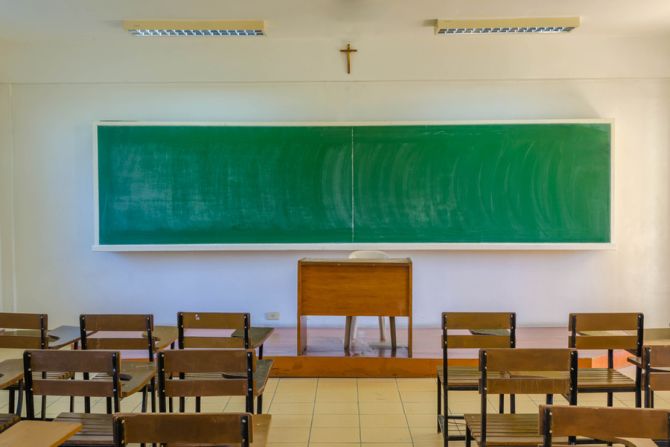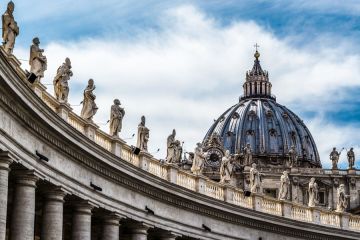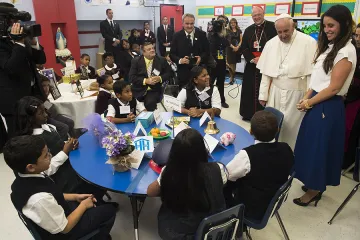Vatican City, Apr 11, 2022 / 02:45 am
What makes a school or university Catholic? As far as universities are concerned, Pope John Paul II answered this question with his apostolic constitution Ex corde Ecclesiae in 1990, which established criteria to regulate the work of universities that called themselves Catholic.
Although Ex corde Ecclesiae is considered a general guideline for all Catholic educational institutions, there is curiously only one reference to it in the Vatican Congregation for Catholic Education’s recent instruction on Catholic schools.
The rather extensive document, called “The Identity of the Catholic School for a Culture of Dialogue,” is a practical guide for all schools that want to claim the title of Catholic.
The instruction had been in the works for years. In 2015, a congress on Catholic education took place in the Vatican and the Congregation immediately set to work on a “directory” for all Catholic schools. According to a Vatican official involved in the preparatory meetings, the directory was intended to present “a pragmatic application of Ex corde Ecclesiae.”
Ex corde Ecclesiae said that the specific purpose of a Catholic university is “to help students think rigorously, act rightly and serve the cause of humanity better.” John Paul II provided guidelines for universities to be included in the broad scope of Catholic learning institutions. This means that the Christian orientation cannot be left to happenstance — it has to develop uniformly all over the world.
What changes, then, with the instruction from the Congregation for Catholic Education, released on March 29?
Not much in the end, though it does offer a solid anchorage for Catholic identity. It also places great responsibility on diocesan bishops in discerning what may or may not be considered a Catholic school.
We read in the instruction that a Catholic school is “endowed with a specific identity,” namely “its reference to a Christian concept of life centered on Jesus Christ.”
The instruction also says: “Following the doctrine of the Church, it is therefore necessary for the school itself to interpret and establish the necessary criteria for the recruitment of teachers. This principle applies to all recruitments, including that of administrative personnel.”
“The relevant authority, therefore, is required to inform prospective recruits of the Catholic identity of the school and its implications, as well as of their responsibility to promote that identity.”
“If the person being recruited does not comply with the requirements of the Catholic school and its belonging to the Church community, the school is responsible for taking the necessary steps. Dismissal may also be resorted to, taking into account all circumstances on a case-by-case basis.”
The measures go as far as dismissal also because teachers are asked to be “outstanding in correct doctrine and integrity of life.” School staff who belong to other Christian churches and religious confessions have the “obligation to recognize and respect the Catholic character of the school from the moment of their employment.”
But the instruction emphasizes that “the predominant presence of a group of Catholic teachers can ensure the successful implementation of the educational plan developed in keeping with the Catholic identity of the schools.”
What changes with this new instruction is the focus, which is more on evangelization than identity. The document also seeks to bring the social sciences to the center of the educational project.
It says: “Evangelization and integral human development are intertwined in the Church’s educational work.” The Church “aims not only to ensure the maturity proper to the human person, but above all to ensure that the baptized, gradually initiated into the knowledge of the mystery of salvation, become ever more aware of the gift of faith.”
The instruction cannot be read separately from another document of Pope Francis, the apostolic constitution Veritatis gaudium, which redesigned the tasks and structures of ecclesiastical universities.
(Story continues below)
In that constitution, Pope Francis called for a cultural revolution based on four criteria: the contemplation of the mystery, wide-ranging dialogue, a plurality of knowledge, and networking. Veritatis gaudium emphasized an interdisciplinary approach, which, in Pope Francis’ view, can inspire a “culture of encounter.”
Not by chance, the Pontifical Institute for Studies on Marriage and Family, established by John Paul II in 1981, was upgraded and reformed. It was expanded to include a series of social sciences classes that aimed to broaden the cultural background. The “Gaudium et Spes” Chair inaugurated at the institute in 2018 underlined this new direction.
The Congregation for Catholic Education’s instruction offers an excellent example of Pope Francis’ thinking. Despite a general opening to dialogue with the world, the Church remains hierarchical, and so does education.
There are passages in the document that confirm in a bureaucratic way what Catholic schools should be and what the local bishop’s responsibilities are.
Then there are more poetic sections asserting that education consists in “a polyphony of movements,” and even that it “unleashes an ecological movement, since it contributes to the recovery of different levels of balance: inner balance with oneself, solidarity with others, natural balance with all living beings, spiritual balance with God.”
There is also a section on the Global Compact on Education, strongly desired by Pope Francis, under which “a long-term project is launched to form people who are willing to put themselves at the educational service of their community.”
“A concrete pedagogy — based on bearing witness, knowledge, and dialogue — is a starting point for personal, social and environmental change,” the document adds.
The instruction acknowledges that there are divergent interpretations of the term “Catholic.”
“The basic problem lies in the concrete application of the term ‘Catholic,’ a complex word that is not easily expressed by means of exclusively legal, formal and doctrinal criteria,” it says.
“The causes of tensions are mainly the result on the one hand of a reductive or purely formal interpretation, and on the other of a vague or narrow understanding of Catholic identity.”
Perhaps there is an allusion here to the question of the Pontifical Catholic University of Peru, which was deprived of its title in 2012 precisely because its statutes did not adhere to Ex corde Ecclesiae. Pope Francis established a commission of cardinals in 2014, which proceeded to rewrite the statutes until, in 2016, the university resumed using the title.
It is worth looking back at the events that led to the loss of the title to realize that, even today, such a case would be handled the same way.
The university was accused of having “unilaterally changed” its statutes since 1967. From 1990 onward, it was asked by the Vatican on many occasions to adapt its laws to the apostolic constitution, but did not do so.
After a canonical visitation in 2011 and a meeting between the rector and the Vatican Secretary of State in 2012, there was a further attempt to adapt the statutes to canon law. The rector wrote to the Secretary of State explaining it was impossible to make the changes due to the Archdiocese of Lima’s refusal to cede control of the management of the activities of the university. The Holy See underlined that the involvement of the archdiocese in the power of the university’s asset management had been confirmed on several occasions, with judgments of civil courts in Peru.
In the 2022 instruction, we read that “the specific charism with which Catholic identity is lived out does not justify a reductive interpretation of catholicity that explicitly or de facto excludes essential principles, dimensions, and requirements of the Catholic faith.”
“Moreover,” it continues, “catholicity cannot be attributed only to certain spheres or to certain persons, such as liturgical, spiritual or social occasions, or to the function of the school chaplain, religion teachers or the school headmaster.”
There is to be no discount, therefore, in terms of faith and doctrine. And the document emphasizes the importance of an institution’s statutes. “Sometimes they are not up to date,” it notes, “they do not clearly illustrate competences or new procedures; they are designed too rigidly to the point of regulating general situations without leaving room for discernment or possible solutions that can only be found at local level.”
Furthermore, the document underlines that conflicts in the disciplinary or doctrinal field “can bring discredit to the Catholic institution and scandal in the community” and therefore “cannot be underestimated.”
It also explains that there are cases in which “state laws impose choices that conflict with religious freedom and the very Catholic identity of a school.”
“While respecting the different spheres, there is a need for reasonable defense of the rights of Catholics and their schools both through dialogue with state authorities and through recourse to the courts having jurisdiction in these matters,” it says.
One cannot but think, for example, of the battle of the Little Sisters of the Poor against the Obama administration’s “contraception mandate.” Pope Francis met with the sisters amid their battle during his 2015 trip to the United States.
The document on Catholic schools could thus be considered old-fashioned, even traditional in its approach. But in any case, the culture of encounter has a limit on identity. And perhaps it is a sign that when it comes to education, the pope, beyond his steps forward, does not want to change much of what is already there.






